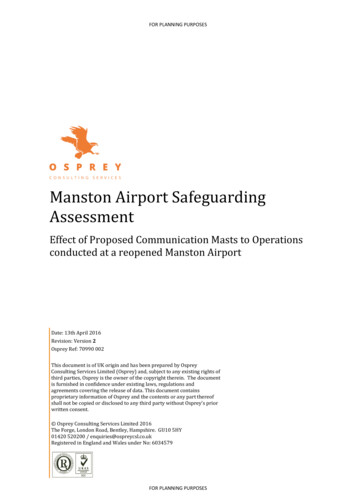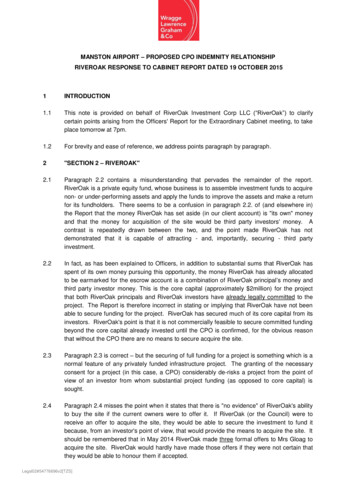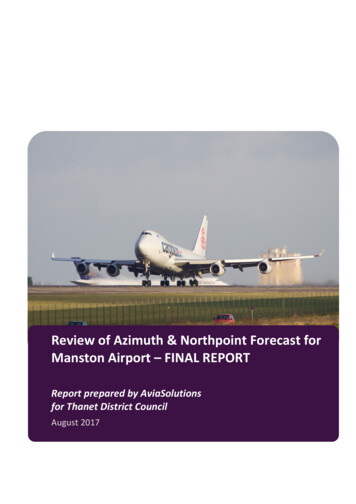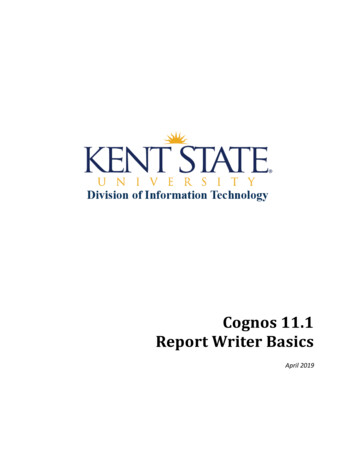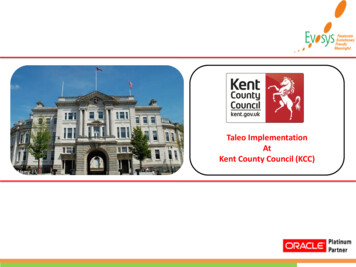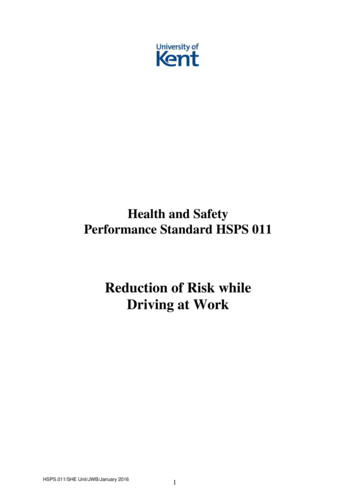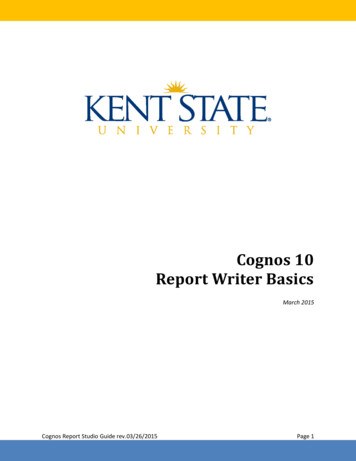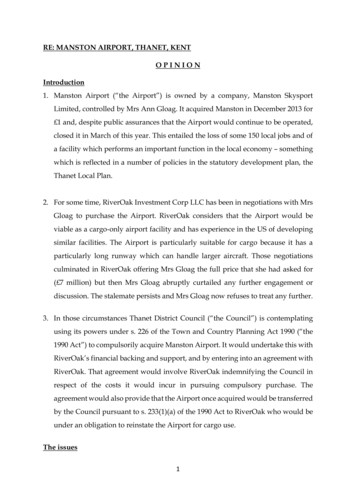
Transcription
RE: MANSTON AIRPORT, THANET, KENTOPINIONIntroduction1. Manston Airport (“the Airport”) is owned by a company, Manston SkysportLimited, controlled by Mrs Ann Gloag. It acquired Manston in December 2013 for 1 and, despite public assurances that the Airport would continue to be operated,closed it in March of this year. This entailed the loss of some 150 local jobs and ofa facility which performs an important function in the local economy – somethingwhich is reflected in a number of policies in the statutory development plan, theThanet Local Plan.2. For some time, RiverOak Investment Corp LLC has been in negotiations with MrsGloag to purchase the Airport. RiverOak considers that the Airport would beviable as a cargo-only airport facility and has experience in the US of developingsimilar facilities. The Airport is particularly suitable for cargo because it has aparticularly long runway which can handle larger aircraft. Those negotiationsculminated in RiverOak offering Mrs Gloag the full price that she had asked for( 7 million) but then Mrs Gloag abruptly curtailed any further engagement ordiscussion. The stalemate persists and Mrs Gloag now refuses to treat any further.3. In those circumstances Thanet District Council (“the Council”) is contemplatingusing its powers under s. 226 of the Town and Country Planning Act 1990 (“the1990 Act”) to compulsorily acquire Manston Airport. It would undertake this withRiverOak’s financial backing and support, and by entering into an agreement withRiverOak. That agreement would involve RiverOak indemnifying the Council inrespect of the costs it would incur in pursuing compulsory purchase. Theagreement would also provide that the Airport once acquired would be transferredby the Council pursuant to s. 233(1)(a) of the 1990 Act to RiverOak who would beunder an obligation to reinstate the Airport for cargo use.The issues1
4. I am asked for my opinion on a number of matters:1) Whether in principle an agreement along the broad lines of that mootedabove, if entered into between the Council and RiverOak, would be subjectto the Public Contracts Regulations 2006 which transpose Directive2004/18/EC on the coordination of procedures for the award of publicworks contracts, public supply contracts and public service contracts (“theDirective”);2) Whether there is any unlawful State aid issue that arises from what scontemplated;3) Whether the Council needs to carry out its own "Feasibility Study" into theviability of reinstating the Airport use before resolving in principle to useCPO powers;4) Whether the Council itself needs to make an offer to acquire the Airportbefore it resolves in principle to use CPO powers;5) Whether what is proposed involves any personal financial risk toCouncillors.5. In relation to 1) and 2) above I should say that at this stage I have not seen anydraft agreement and proceed simply on the basis of the broad outline of what iscontemplated as set out above.(i)The procurement issueThe legal framework6. The aims and purposes of the Directive are: “to ensure that public bodies awardcertain contracts above a minimum value only after fair competition, and that theaward is made to the person offering the lowest price or making the mosteconomically advantageous offer”: Risk Management Partners Ltd v LondonBorough of Brent [2011] 2 A.C. 34 at para. 10 per Lord Hope.2
7. Reg. 2 of the 2006 Regulations defines “public contract” as meaning “a publicservices contract, a public supply contract or a public works contract”. To becaught by the 2006 Regulations an agreement must be a “public contract” 1.8. Reg 2 then defines:1) “public services contract” as meaning “a contract, in writing, forconsideration (whatever the nature of the consideration) under which acontracting authority engages a person to provide services but does notinclude— (a) a public works contract; or (b) a public supply contract”.“Services” are those listed in Schedule 3 and includes transport by air;2) “public supply contract” as meaning “a contract, in writing, forconsideration (whatever the nature of the consideration)— (a) for thepurchase of goods by a contracting authority (whether or not theconsideration is given in installments and whether or not the purchase isconditional upon the occurrence of a particular event), or (b) for the hire ofgoods by a contracting authority (both where the contracting authoritybecomes the owner of the goods after the end of the period of hire andwhere it does not); and for any siting or installation of those goods, butwhere under such a contract services are also to be provided, the contractshall only be a public supply contract where the value of the considerationattributable to the goods and any siting or installation of the goods is equalto or greater than the value attributable to the services”; and3) “public works contract” as meaning “a contract, in writing, forconsideration (whatever the nature of the consideration)— (a) for thecarrying out of a work or works for a contracting authority; or (b) underwhich a contracting authority engages a person to procure by any meansthe carrying out for the contracting authority of a work corresponding tospecified requirements”. In the 2006 Regulations “work” means “the“public contracts” is defined in Article 1(2)(a) of the Directive as follows:“‘Public contracts’ are contracts for pecuniary interest concluded in writing between one or moreeconomic operators and one or more contracting authorities and having as their object the execution ofworks, the supply of products or the provision of services within the meaning of this Directive.”13
outcome of any works which is sufficient of itself to fulfil an economic andtechnical function” and “works” are defined in Schedule 2 – this includesmost building operations e.g. construction, demolition, building installationetc;4) a “services concession contract” as meaning “a public services contractunder which the consideration given by the contracting authority consistsof or includes the right to exploit the service or services to be providedunder the contract”.9. Reg. 6(2)(m) excludes from the scope of the 2006 Regulations “a servicesconcession contract awarded by a contracting authority, subject to the applicationof regulation 46” 2. This exclusion is derived from the Directive itself.10. The Advocate-General in Case C ‑ 196/08 Acoset SpA v Conferenza Sindaci ePresidenza Prov. Reg. ATO Idrico Ragusa and Others said:“75. The present reference for a preliminary ruling throws into relief the first difficulties inthe task of distinguishing a public service contract from a public service concession.76. A public service contract involves consideration which is paid directly by thecontracting authority to the service provider; however, where the remuneration comes notfrom the public authority concerned, but from sums paid by third parties benefiting fromthe service, there is a public service concession.77. In addition, the transfer of the operating risk is one of the most valuable clues for thepurposes of examining that distinction, because it is an essential element of a concessionbut does not feature in a contract.”.11. In JBW Group Ltd v Ministry of Justice [2012] 2 C.M.L.R. 10 the Court of Appealsaid“40 As the EU authorities show, the paradigm case of a service contract is where the applicantperforms a service for the authority and is paid an agreed fee for that service “46.— Public service bodies(1) Where a contracting authority, other than one which is a contracting authority only by reason ofbeing a Schedule 1 entity, grants to a person other than a contracting authority, special or exclusiverights to carry on a service for the benefit of the public, it shall impose an express duty on that personin the terms referred to in paragraph (2).(2) The duty referred to in paragraph (1) is a duty not to discriminate in seeking offers in relation to, orin awarding, a contract for the purchase or hire of goods on the grounds—(a) of nationality, against a person who is a national of and established in a relevant State; or(b) that the goods to be supplied under the contract originate in another relevant State.”24
41 The paradigm case of a concession is where the applicant is put in possession of a businessopportunity which he can exploit by providing services to third parties and charging themdirectly for those services. The contractor then bears the risks of running the business whichare typically greater than those involved in performing a contract for a fixed fee. The ParkingBrixen [2006] 1 C.M.L.R. 3 and Wasser [2009] E.C.R. I-8377 cases are classic examples of suchcontracts, albeit that the risk in the latter case was limited. The fact that there may be someregulation of the price which the contractor can charge the third party for the service does notof itself prevent the arrangement constituting a concession. 43 a concession usually involves a direct contractual relationship with third party clients orcustomers of the service who are charged directly by the contractor.44 as Oymanns [2009] E.C.R. I-4779 makes clear, the concessionaire typically hasconsiderable control over the manner in which the service is provided; the authority takes aback seat 45 Finally, in a classic concession, although the contracting authority has an interest in theservice being performed for the benefit of third parties, it does not itself directly benefit fromits performance, as in this case.”12. Reg. 6(2)(e) provides that the 2006 Regulations do not apply to a contract “for theacquisition of land, including existing buildings and other structures” 3.13. In Case C-306/08 Commission v. Spain [2011] 3 C.M.L.R. 43 the CJEU noted thatit was clear “from the case law of the Court that, where a contract containselements relating both to a public works contract and another type of contract, it isthe main object of the contract which determines which body of EU rules on publiccontracts is to be applied in principle (see, to that effect, Auroux [2007] E.C.R. I-385at [37]).”Analysis14. First, self-evidently the contemplated agreement is not a “public supply contract”.15. Second, the contemplated agreement entails, as I understand it, no requirement forany work or works, as defined in Schedule 3 or otherwise, to be done. Theobligation imposed on RiverOak will merely be to reinstate the use; and this canbe done without any works being done. It certainly will not involve works beingIn R (Midlands Co-operative Society Limited) v Birmingham CC [2012] EWHC 620 (Admin)Hickinbottom J. left open a question whether the 2006 Regulations do not properly implement theDirective because Article 16(a) of the Directive provides that it shall not apply to public service contractsfor the acquisition of land, whereas reg. 6(2)(2) of the 2006 Regulations disapplies their effect to anypublic contract (including a public works contract) for the acquisition of land.35
done to the requirements of the Council. Any future plans for improvements oralterations to the Airport would be entirely a matter for RiverOak, subject toobtaining any necessary planning permission, and wholly outside the terms of anyagreement with the Council. The essential characteristic of a public works contract“is a binding and legally enforceable obligation in the contractor to executerelevant works as specified by the contracting authority”: see the Co-operativecase (referred to above) at para. 97 and Case C-451/08 Helmut Müller GmbH v.Bundesanstalt für Immobilienaufgaben [2011] P.T.S.R. 200 at para. 63. That issimply not what is proposed here.16. Finally, is what is contemplated arguably a “public services contract”?17. It is correct that air transport services are listed as being within the Schedule to the2006 Regulations but in my view the agreement contemplated here would beoutwith the 2006 Regulations and the Directive for a number of reasons:18. First, RiverOak are not agreeing to provide services, as contemplated in Schedule3 or at all. The agreement does not involve RiverOak promising to provide servicesto the Council or indeed anyone else. The agreement merely obliges RiverOak topurchase the Airport and once purchased to reinstate the Airport for cargo use. Ithink it can be convincingly argued that reinstating the use of the Airport does notitself involve any service being provided at all pursuant to the agreement.RiverOak in reinstating the use may well provide services to third parties but thatwill be pursuant to such agreements with operators etc. that it enters into in thecourse of it operating the Airport it has acquired. It will not be providing thoseservices under the contemplated agreement with the Council.19. Second, if there is service provision here at all under the contemplated agreement(and I doubt there is), then in many ways what is contemplated may be seen as aservices concession agreement or at least something very closely akin thereto: seethe case-law set out above. Such contracts are expressly excluded from the 2006Regulations and/or the Directive.6
20. Third, it seems to me strongly arguable that the contemplated agreement couldalso be said to be outside of the scope of a “public services contract” on the basisthat its main purpose is the acquisition of land (see above).(ii)The State Aid issue21. Under Article 107(1) of the TFEU public authorities are prohibited from givingfinancial assistance (direct or indirect) to businesses where that meets all thecriteria in Art. 107(1) of the Treaty on the Functioning of the European Union.22. Objectors to CPO often raise State aid issues. Thus far such matters have neverbeen successfully deployed to defeat a CPO process. The arguments that can beraised vary. To avoid any pitfalls on State aid it is essential that any agreementbetween the Council and RiverOak provides that RiverOak fully indemnify theCouncil for any costs it incurs in the CPO process. Assuming that this is done thatwill itself go a long way to defeating any State aid arguments. The detailed draftingof any agreement will require careful consideration but I see no reason why theagreement cannot be concluded in a way that avoids any unlawful State aid.(iii)The feasibility report issue23. The Council at this stage is, I understand, merely considering whether to resolvein principle to use its CPO powers. One of the tests for confirmation of a CPOunder s. 226 of the 1990 Act is (see para. 16 of Appendix A to ODPM Circular06/2004):“the potential financial viability of the scheme for which the land is being acquired. A generalindication of funding intentions, and of any commitments from third parties, will usuallysuffice to reassure the Secretary of State that there is a reasonable prospect that the scheme willproceed. The greater the uncertainty about the financial viability of the scheme, however, themore compelling the other grounds for undertaking the compulsory purchase will need to be.The timing of any available funding may also be important. For example, a strict time-limit onthe availability of the necessary funding may be an argument put forward by the acquiringauthority to justify proceeding with the order before finalising the details of the replacementscheme and/or the statutory planning position”7
24. RiverOak will in due course need to produce a business plan, and it may be thatthe Council will need to retain consultants to help them assess and verify that pieceof work (and the costs of which they will be indemnified in respect of). Beforeactually making the CPO the Council will need to be satisfied that “there is areasonable prospect of the scheme going ahead” that is to say that “that it isunlikely to be blocked by any impediments to implementation” including“potential financial impediments” (see para. 20 of the Memorandum to ODPMCircular 06/2004). However, even at that stage there is no need for the Council tohave done its own feasibility study. At this stage, when all that is being consideredis whether in principle to use CPO powers, any such study is clearly not needed.If the Council is concerned it could expressly resolve to use its powers in principle,subject to being satisfied by RiverOak that reinstatement of the Airport isfinancially viable.(iv)The offer issue25. It is correct that Memorandum to ODPM Circular 06/2004 says that “acquiringauthorities should seek to acquire land by negotiation wherever practicable” (para.24) and that “[t]he compulsory purchase of land is intended as a last resort in theevent that attempts to acquire by agreement fail” (ibid). This does not mean thatthe Council itself must have made an offer in circumstances where what isintended is that the land acquired be transferred to RiverOak. The Council caninstead satisfy itself that RiverOak have made reasonable efforts to acquire theland. There is little doubt that they have. It is in my experience very common foracquiring authorities to rely on negotiations carried out by others as showing thata voluntary sale will not be possible.(v)The Councillor liability issue26. I am asked whether what is proposed involves any risk of personal liability toCouncillors via surcharge or otherwise.27. There are a number of points to be made:8
28. First, what is proposed involves RiverOak agreeing to indemnify the Council inrespect of all its costs of pursuing the CPO. Given that the Council itself is veryunlikely to suffer any losses at all, and on that basis it is difficult to see whatliability there might be on the part of Councillors themselves.29. Second, there are no longer has any statutory powers to surcharge councilors. Suchpowers used to be vested in the Audit Commission/District Auditor. Thesepowers were repealed by the Local Government Act 2000.30. Third, despite the removal of the statutory scheme councillors are in the positionof trustees of the public funds which they control (see Attorney General ex rel Reav Belfast Corpn (1855) 4 Ir Ch R 119, 143, 156). Were they to act in breach of trustthey may be liable to their authority. But assuming that councillors act on legaladvice – the cost of which it will be indemnified in respect of – I simply cannot seethere is any realistic prospect of a breach of trust.Conclusion31. In these circumstances my opinion is that:1) the 2006 Regulations would not apply to the contemplated agreementbetween RiverOak and the Council. I should be happy in due course toconsider the contemplated agreement in more detail but at present I cannotsee that the 2006 Regulations and/or the Directive are applicable;2) the agreements entered into can be drafted in such a way as to avoid anyrisk of unlawful State aid;3) There is no need for the Council to commission its own feasibility study onreinstating Airport use nor to itself make any offer for the Airport;4) Given that there will be an indemnity, and assuming that the Council actsin accordance with legal advice, there is no realistic prospect of a personalfinancial risk to Councillors.9
32. If I can be of any further assistance please do not hesitate to contact me inChambers.JAMES MAURICI QCLandmark Chambers180 Fleet StreetLondonEC4A 2HGFriday, July 04, 201410
RE: MANSTON AIRPORT, THANET, KENTOPINIONClare FieldingPartner – Planning teamDDI: 44 (0)20 7759 6533M: 44 (0)7809 2002144 More London Riverside, London SE1 2AU11
2. For some time, RiverOak Investment Corp LLC has been in negotiations with Mrs Gloag to purchase the AirportRiverOak considers that . the Airport would be viable as a cargo-only airport facility and has experience in the US of developing similar facilities. port The Airis particularly suitable for cargo because it
